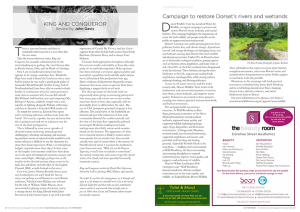
There is accurate history and there is watchable television but it is not often that the two meet. Take the recent television series King and Conqueror, for example-a dramatization of the events leading up to perhaps the most famous date in British history, 1066, and the Battle of Hastings.
Now I am no medieval historian but there appears to be strange anomalies here. Would the Pope have made Edward the Confessor into a saint had he known he was really a psychopath guilty of matricide? Would Harold’s brother Tostig, Earl of Northumberland, have been able to control volatile hordes of northerners when his screen persona is more akin to someone who has just left school? Did William’s half-brother, wan and simpering Odo, Bishop of Bayeux, suddenly morph into a man capable of fighting alongside William at Hastings and then to become a Crusader? Well maybe not.
To tempt the viewer in, Episode One opens with a terrifying and noisy combat scene from the ‘battle’. Not exactly a spoiler, because we know how this is going to end and not in a pleasant way for one of the chief protagonists.
This is followed by some seven episodes of eleventh century conniving, betrayal, general skullduggery, wheeling and dealing and marriage negotiations mostly conducted inside candlelit castle rooms where it is difficult to see the characters let alone their facial expressions. What is it with lighting budgets on productions these days? At least some of the lengthy conversations could have been done out in the open affording both attractive scenery and more natural light. Although, perhaps not, as the weather in the eleventh century always seems to be dark, wet and blowy on both sides of the English Channel. (Well, actually Iceland in this case.)
Cast-wise, James Norton (Harold) always gives one hundred per cent and I liked the fact an actor, not perhaps so well known to some British audiences, Nikolaj Coster-Waldau, was selected for the role of William. Eddie Marsan, more accustomed to playing strong characters, seems a strange choice for King Edward while Juliet Stevenson (Lady Emma) hypes it up with a passable impression of Cruella De Vil on a bad day. Great support from other female leads comes from Emily Beecham, Clemence Poesy and as always Clare Holman.
Costumes look appropriate throughout although I’m not sure royalty and nobility in those days were guilty of so much dressing down. Make-up must have been minimal as everyone appears grubby and in need of a good hair wash and tidy and it amazes me in all historical film productions how age, illness, violence, disfigurement frequently ravages characters but never seems to prevent them from displaying a surgery-fresh set of teeth.
The close-up scenes of the battle itself are impressively done giving a convincing portrayal of how noisy, gory and intense one-to-one warfare must have been in those days especially with no discernible livery to differentiate the sides. The use of CGI (computer generated imagery) is less effective. The aerial views of the battlefield are blurred and give little indication of how each commander directed the conflict tactically and the view of the huge fleet supposedly gathered to transport William’s invading army looks nothing more than fluffy cotton-wool cumulus clouds on the horizon. The appearance of what was to become known as Halley’s comet arrives conveniently but six months later than records actually state and of course there is the travesty of Harold’s fateful arrow. I can hear the production crew discussion now: “Well, it’s on the Bayeux Tapestry, so we’ll have to include it somewhere”. An entirely wrong time and means to get the ‘point’ across, I’m afraid, and most possibly historically inaccurate anyway.
King and Conqueror; written by David Mar Stefansson; directed by Erik Leijonborg; BBC/IPlayer; eight episodes.
Postscript: If you have the staying power, see it through and enjoy it as the drama it is intended to be. Get to the end of Episode Eight first and then take out your authoritative sources and texts and research what actually came to pass in 1066 when Saxon and Norman cultures became inextricably conjoined.



